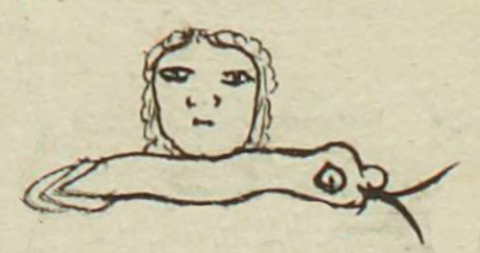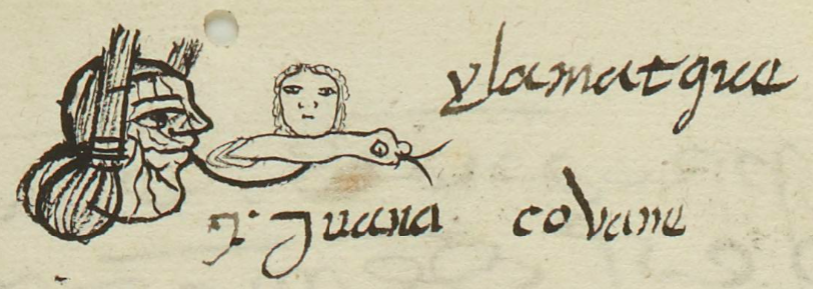Coanen (MH600r)
This black-line drawing of the compound glyph for the personal name Coanen (“Idle Serpent," "Serpent-Divine Force Image," or "Serpent-Doll,”) is attested here as a woman's name. It shows a horizontal serpent (coatl) with a rattler tail and a protruding, bifurcated tongue. Above and in the middle of the snake is what may be a doll's (nenetl) head or a figurine of a divine force (ixiptla). Typically, this is a phonetic syllable for "lazy," "useless," or "idle." This is a frontal view of a human-like face, perhaps a female.
Stephanie Wood
A famous woman of Chalco in the fifteenth century was called Coanentzin (with the reverential suffix, as she was a member of the nobility). Deciding how one should translate her name is something of a challenge. Alonso de Molina gives three very different definitions for nenetl ("idol," doll, and woman's genitals). Of the three possibilities, this visual appears to fit "doll" the best. Aside from this one, two other nenetl examples that have been identified so far (June 2023) seem to suggest girl dolls (thin, with skirts). But often, in the Matrícula de Huexotzinco (this same manuscript), the nenetl can be represented as a deity image (or "idol" in Molina's terms). In most of these, it is the phonetic prefix Nen- that is the target reading, and in these cases the phonetic Nen- refers to negative behaviors, nothing about divine forces. Finally, there is one more example of a woman representing the suffix -nene. In that attestation, the addition of the chalchihuitl next to her hips may serve as a subtle semantic indicator that genitals are meant. (Gordon Whittaker suggested this in a personal communication, April 2023.)
Stephanie Wood
juana covane
Juana Coanen
Stephanie Wood
1560
Stephanie Wood
serpents, snakes, serpientes, culebras, víboras, esculturas, sculptures, figurillas, dolls, muñecas, ixiptla, nenetl, inútiles, cohuatl, viudas, viejas, nombres de princesas, nombres de mujeres, crótalos

coa(tl), serpent, snake, https://nahuatl.wired-humanities.org/content/coatl
nene(tl), doll or deity figure, https://nahuatl.wired-humanities.org/content/nenetl
Serpiente Inútil, o Serpiente-Muñeca, o Serpiente-Imagen Divina
Stephanie Wood
Matrícula de Huexotzinco, folio 600r, World Digital Library, https://www.loc.gov/resource/gdcwdl.wdl_15282/?sp=279st=image.
This manuscript is hosted by the Library of Congress and the World Digital Library; used here with the Creative Commons, “Attribution-NonCommercial-ShareAlike 3.0 License” (CC-BY-NC-SAq 3.0).










